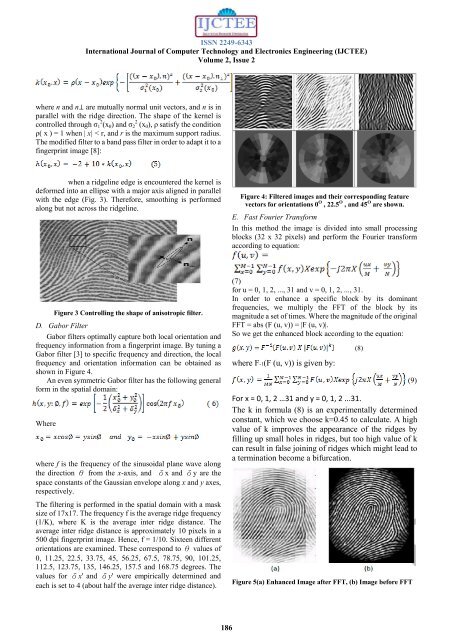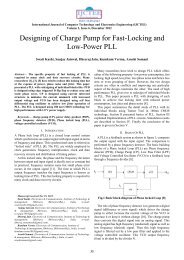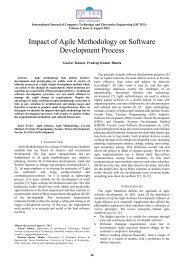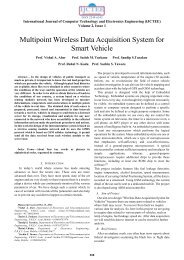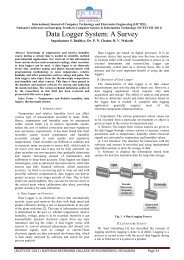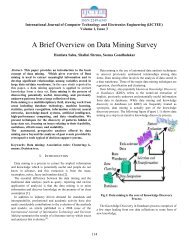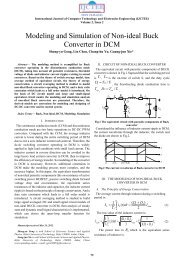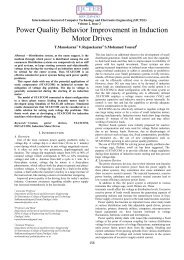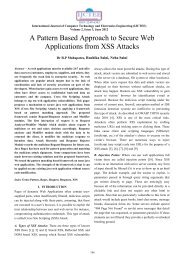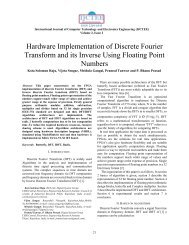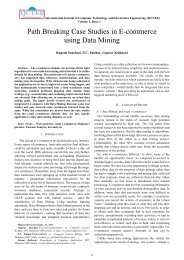Fingerprint Image Enhancement Techniques and Performance ...
Fingerprint Image Enhancement Techniques and Performance ...
Fingerprint Image Enhancement Techniques and Performance ...
Create successful ePaper yourself
Turn your PDF publications into a flip-book with our unique Google optimized e-Paper software.
ISSN 2249-6343International Journal of Computer Technology <strong>and</strong> Electronics Engineering (IJCTEE)Volume 2, Issue 2where n <strong>and</strong> n⊥ are mutually normal unit vectors, <strong>and</strong> n is inparallel with the ridge direction. The shape of the kernel iscontrolled through σ 1 2 (x 0 ) <strong>and</strong> σ 2 2 (x 0 ), ρ satisfy the conditionρ( x ) = 1 when | x| < r, <strong>and</strong> r is the maximum support radius.The modified filter to a b<strong>and</strong> pass filter in order to adapt it to afingerprint image [8]:when a ridgeline edge is encountered the kernel isdeformed into an ellipse with a major axis aligned in parallelwith the edge (Fig. 3). Therefore, smoothing is performedalong but not across the ridgeline.Figure 4: Filtered images <strong>and</strong> their corresponding featurevectors for orientations 0 O , 22.5 O , <strong>and</strong> 45 O are shown.E. Fast Fourier TransformIn this method the image is divided into small processingblocks (32 x 32 pixels) <strong>and</strong> perform the Fourier transformaccording to equation:Figure 3 Controlling the shape of anisotropic filter.D. Gabor FilterGabor filters optimally capture both local orientation <strong>and</strong>frequency information from a fingerprint image. By tuning aGabor filter [3] to specific frequency <strong>and</strong> direction, the localfrequency <strong>and</strong> orientation information can be obtained asshown in Figure 4.An even symmetric Gabor filter has the following generalform in the spatial domain:Wherewhere f is the frequency of the sinusoidal plane wave alongthe direction θ from the x-axis, <strong>and</strong> δx <strong>and</strong> δy are thespace constants of the Gaussian envelope along x <strong>and</strong> y axes,respectively.The filtering is performed in the spatial domain with a masksize of 17x17. The frequency f is the average ridge frequency(1/K), where K is the average inter ridge distance. Theaverage inter ridge distance is approximately 10 pixels in a500 dpi fingerprint image. Hence, f = 1/10. Sixteen differentorientations are examined. These correspond to θ values of0, 11.25, 22.5, 33.75, 45, 56.25, 67.5, 78.75, 90, 101.25,112.5, 123.75, 135, 146.25, 157.5 <strong>and</strong> 168.75 degrees. Thevalues for δx' <strong>and</strong> δy' were empirically determined <strong>and</strong>each is set to 4 (about half the average inter ridge distance).(7)for u = 0, 1, 2, ..., 31 <strong>and</strong> v = 0, 1, 2, ..., 31.In order to enhance a specific block by its dominantfrequencies, we multiply the FFT of the block by itsmagnitude a set of times. Where the magnitude of the originalFFT = abs (F (u, v)) = |F (u, v)|.So we get the enhanced block according to the equation:where F-1(F (u, v)) is given by:For x = 0, 1, 2 …31 <strong>and</strong> y = 0, 1, 2 ...31.The k in formula (8) is an experimentally determinedconstant, which we choose k=0.45 to calculate. A highvalue of k improves the appearance of the ridges byfilling up small holes in ridges, but too high value of kcan result in false joining of ridges which might lead toa termination become a bifurcation.Figure 5(a) Enhanced <strong>Image</strong> after FFT, (b) <strong>Image</strong> before FFT(8)(9)186


